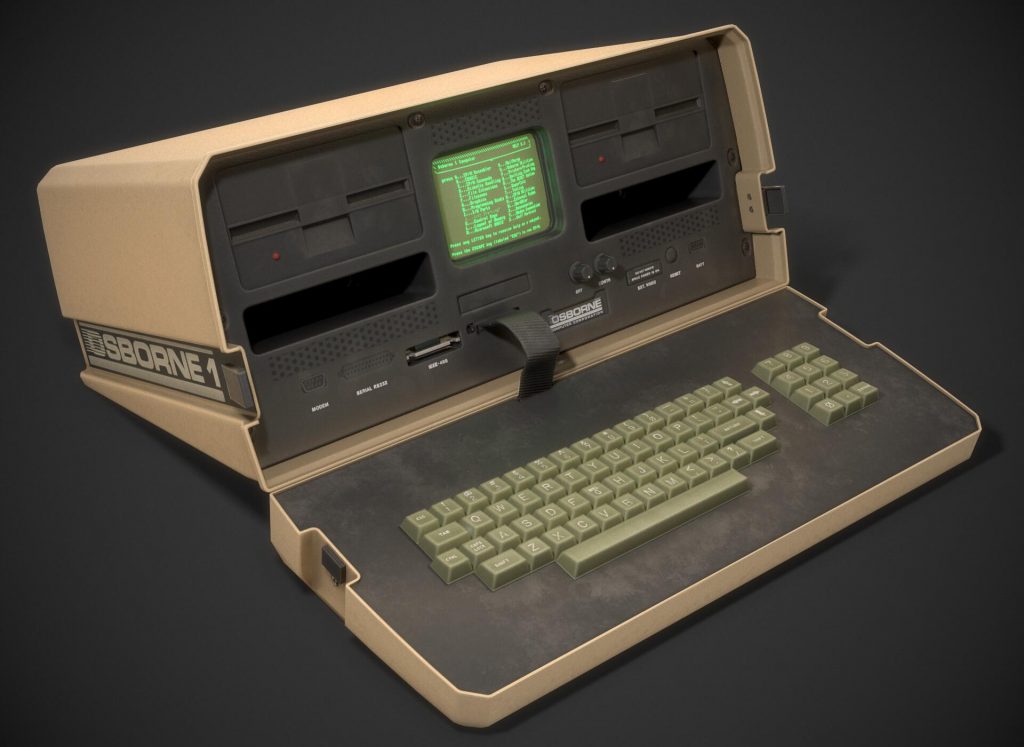Adam Osborne’s self-named company released the Osborne 1 on April 4, 1981, forty years ago.
The Osborne 1 was the first transportable business computer, though it certainly wasn’t portable. At 10kg, it was as heavy as a suitcase and should have had wheels built into the casing. It did not have a battery, so it could only be used in situ, with the power cord plugged in.
Having said that, the Osborne 1 was a full-fledged computer, as powerful as any desktop PC of the day. It used the CP/M operating system and could run many powerful applications of the day: CBASIC, dBase II, SuperCalc, and many others that came bundled with the machine. With a Z80 processor, 64kb of RAM (128 on the later model), two 360kb floppy drives, a 80×25 text screen, and ports for external connections, it wasn’t lacking for power.
What Osborne did lack was good management and an affordable price. US$1800 was exorbitant, even for IBM. The company overextended itself which (along with the IBM PC’s dominance of the market) led to the company’s collapse in 1984. It was a short but wild ride.
More below the fold.

Here are a few items on the Osborne 1’s place in history:
History-Computer: The History of the Osborne 1
ZDNet: The Osborne 1: A pioneer in more ways than one
Old Computers dot com: The Osborne 1
The 8Bit Guy did a two part restoration of an Osborne 1, part 1 and part 2.
From InExhibit dot com:
Osborne 1 (1981) – when the personal computer became portable
The Eighties are also remembered for the obsession many had with fitness and bodybuilding, at those times. And indeed the guy carrying his Osborne 1 “portable” microcomputer in this advertisement must have had a very trained arm to swing the over 24 pounds of plastic, metal, and silicon of the Osborne with a smile.
Designed by American engineer Lee Felsenstein, the Osborne 1 is widely considered the first portable personal computer ever (the IBM 5100 anticipated it by six years but was so outrageously expensive that it’s hard to call it really “personal”*). It had been also the only one produced in high volumes by San Francisco-based Osborne Computer Corporation during its brief life, from 1980 to 1985.
Presented in 1981, the Osborne 1 – which was clearly inspired by one of the many seminal projects developed at the Xerox PARC in Palo Alto, namely the Xerox NoteTaker – was not a laptop (it didn’t have an internal battery) but a computer which could be rather easily moved from one place to another; say, from a businessman’s office in Manhattan to his weekend home on Martha’s Vineyard…
The machine was based on classic Z80-CP/M architecture, with a 4MHz Zilog Z80 processor and 64KB of RAM, and was bundled with a comprehensive software pack which included a word processor, a database, and a spreadsheet. The software bundle was stored on single-side floppy disks, since the machine, like most computers of the time, didn’t include a hard disk drive.
Sometimes it pays to be the first and lead, other times it’s better to follow and learn from others’ mistakes. Osborne clearly was the leader in the second sense, making the mistakes that others didn’t. Still, we wouldn’t have portable computing or laptops without someone showing that it’s possible. Give credit where it’s due.

Another important characteristic of the Osborne was the tiny screen. Naturally, that was bad for use, but it made the computer far more rugged. CRT monitors in the olden days were heavy and delicate.
I used to see a lot of Osbornes back when, although they were supplanted out where I was by Kaypros (similar specs and weight but much bigger screen). Writers loved them cause you could actually write down at your local coffee shop.
“Portable”. Heh! Back in the 1950s, a “portable” videotape machine was one that could be moved at all. By a forklift.
Hence why I called it transportable. Movable, but only with great effort.
I’m impressed that it had disk drives, two even!
I remember hooking up those weird little audio-cassette players to a computer, and trying to sync the little counter dial to when I pressed the play/record buttons and what not…
I had the Osborne Executive and taught myself how to program in CBasic on it during my stay in Asia-Pacific (1980-1984).
Regarding the two drives, the top one was for the application software, the bottom one for the data. Left it in the trunk of a car at Subic Bay during thunderstorm, retrieved it after lunch and a few hours of sunlight to find the case shrunk to the metal frame and keyboard no longer latch-able, To my great pleasure it booted up just fine and gave me several more years of service until replaced by a Hong Kong clone running early Microsoft s/w.
I bought one. It might still be in the basement of my ex’s house.